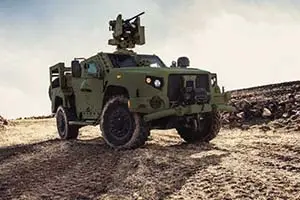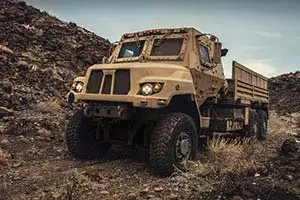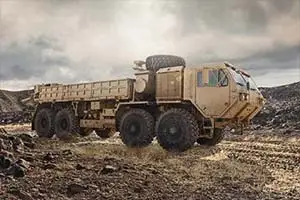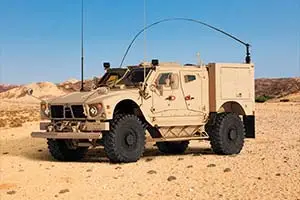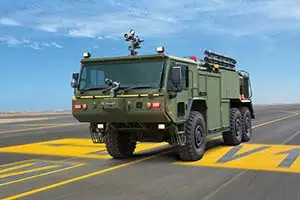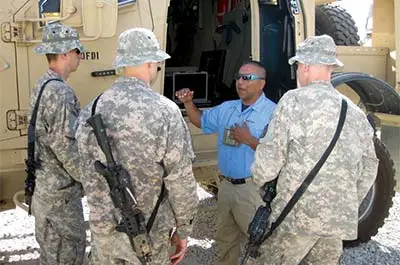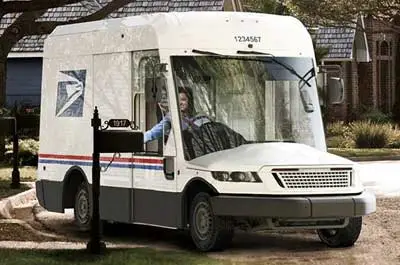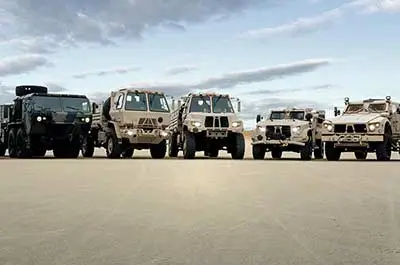OSHKOSH, WIS. (February 20, 2009) – Oshkosh Airport Products Group, a division of Oshkosh Corporation (NYSE:OSK), today announced it has delivered and placed into service at the Denver International Airport 24 Oshkosh® HT-Series™ snow tractor vehicles, one Oshkosh Striker® 4500 aircraft rescue and firefighting vehicles (ARFF) and has four more Strikers on order. The total value of all contracts, including brooms, local support, and training, is over $22 million.
“This delivery of 24 HT-Series snow tractors and Strikers ARFF vehicle demonstrates how Oshkosh multi-tasking equipment is integral to the snow removal and firefighting strategies of large airports. As the world’s leading manufacturer of custom snow removal and ARFF vehicles, Oshkosh offers a wide range of products to meet any airport’s requirements,” said Tim Raupp, Oshkosh Corporation Airport Products Group president. “This landmark order from Denver International Airport is a resounding vote of confidence for both our products and our people.”
The HT-Series vehicles are identically equipped with Oshkosh 24-ft. front-mounted flared plows and 22-ft. towed, tracking, steerable brooms and ALL STEER® electronic all-wheel steering. The HT-Series snow tractor is a unique multi-tasking equipment (MTE) chassis, capable of performing a myriad of functions, including plowing, sweeping, forced air blowing, deicing and more. The HT-Series chassis accepts a wide range of plows, underbody scrapers, material spreaders, tow-behind brooms or combinations of each, depending on a customer’s requirements.
Engineered with the assistance of airport snow removal professionals who operate and manage fleets around the world, the HT-Series chassis is engineered to provide a roomy cab, excellent visibility, built-in safety systems, greater comfort, excellent performance and legendary Oshkosh reliability.
Features found on the Denver HT-Series vehicles include:
« Cab-over chassis design with a wall-to-wall turning circle of less than 75-ft with the tracking, towed broom coupled to the chassis
« Patent-pending cab design with panoramic view, large windshield and no corner posts
« Command Zone™ electronic LCD dash pod
« Two full-sized seats to accommodate a supervisor/training officer
« Easy-to-operate digital climate control and power roll-down windows
« All-wheel drive, proprietary ALL STEER electronic all-wheel steering and Oshkosh 55000 Series transfer case
« 29,000 lb. front axle to accommodate the weight of an airport plow
« 26,000 lb. rear axle to accommodate the weight of a cradling boom
« Oshkosh “hands free” hitch for safe disengagement of the plow from inside the cab
« Safety interlocks with emergency stop feature for attachments
Denver International Airport ordered the three Striker 4500 vehicles after it completed a thorough review process of its existing ARFF fleet that included the purchase and evaluation of a single Striker 4500 apparatus. The airport also ordered a smaller Striker 1500 vehicle for use at its world-class firefighting training facility.
The Striker 4500 features an 8 x 8 axle configuration and proprietary technologies such as TAK-4® independent suspension, triple agent firefighting capabilities and Command Zone™ advanced electronics for enhanced maneuverability, firefighting power and reliability. Other features include:
« 4,500 gallons (17,033 L) of water capacity
« 420 gallons (1,590 L) of foam capacity
« 500 pounds (227 kg) of dry chemical
« Roof turret with 1,200 GPM (4,542 LPM) flow capacity
« High volume, low attack bumper turret with Hydrochem nozzle and 1,200 GPM (4542 LPM) flow
« Pre-connected water and foam hoses
« Oshkosh Rear Steer system to decrease overall turning circle and reduce tire wear
« Caterpillar C18 diesel engine with 950HP and 2,400 ft. lbs of torque
At 52 square miles, Denver International Airport is the largest airport in the United States, and the third largest in the world. Its 16R/34L runway is the longest commercial runway in North America. In 2007, with 49,863,389 passengers, DIA was the eleventh busiest airport in the world as measured by passenger traffic.
The airport is located in extreme northeastern Denver, Colorado, and is operated by the City and County of Denver.
OJ Watson Equipment, Inc. of Denver, Colo., a major distributor of Oshkosh snow removal products, was the primary bidder on the snow equipment order, and will provide local service and support.
« Command Zone and HT-Series are trademarks of Oshkosh Corporation
« Striker, ALL STEER and TAK-4 are registered trademarks of Oshkosh Corporation
About Oshkosh Airport Products
The Oshkosh Airport Group, a division of Oshkosh Corporation, is a designer and builder of industry-leading airport firefighting and snow removal vehicles. Its flagship Striker® Aircraft Rescue and Fire Fighting (ARFF) vehicle and Oshkosh® H-Series™ snow removal chassis are known for their durability and superiorperformance and sold throughout the world. For more information, visit www.oshkoshairport.com.
About Oshkosh Corporation
Oshkosh Corporation is a leading designer, manufacturer and marketer of a broad range of specialty access equipment, commercial, fire & emergency and military vehicles and vehicle bodies. Oshkosh Corp. manufactures, distributes and services products under the brands of Oshkosh®, JLG®, Pierce®, McNeilus®, Medtec®, Jerr-Dan®, BAI®, Oshkosh Specialty Vehicles, Frontline™, SMIT™, Geesink™, Norba™, Kiggen™, CON-E-CO®, London® and IMT®. Oshkosh products are valued worldwide in businesses where high quality, superior performance, rugged reliability and long-term value are paramount. For more information, log on to www.oshkoshcorporation.com.
Forward-looking Statements
This press release contains statements that the Company believes to be “forward-looking statements” within the meaning of the Private Securities Litigation Reform Act of 1995. All statements other than statements of historical fact, including without limitation, statements regarding the Company’s future financial position, business strategy, targets, projected sales, costs, earnings, capital expenditures, debt levels and cash flows, and plans and objectives of management for future operations, are forward-looking statements. When used in this press release, words such as “may,” “will,” “expect,” “intend,” “estimate,” “anticipate,” “believe,” “should,” “project” or “plan” or the negative thereof or variations thereon or similar terminology are generally intended to identify forward-looking statements. These forward-looking statements are not guarantees of future performance and are subject to risks, uncertainties, assumptions and other factors, some of which are beyond the Company’s control, which could cause actual results to differ materially from those expressed or implied by such forward-looking statements. These factors include the consequences of financial leverage associated with the JLG acquisition, especially given turmoil in the credit markets, the level of the Company’s borrowing costs and the Company’s ability to successfully amend its credit agreement to provide financial covenant relief; the cyclical nature of the Company’s access equipment, commercial and fire & emergency markets, especially during a global recession and credit crisis; the Company’s ability to obtain cost reductions on steel and other raw materials following sharp cost increases in 2008, obtain other cost decreases or achieve product selling price increases; the duration of the global recession and its adverse impact on the Company’s share price, which could lead to impairment charges related to many of the Company’s intangible assets; the expected level and timing of U.S. Department of Defense procurement of products and services and funding thereof; risks related to reductions in government expenditures and the uncertainty of government contracts; the potential for commodity costs to rise sharply in a future economic recovery; risks associated with international operations and sales, including foreign currency fluctuations;; risks related to the collectability of receivables during a recession, particularly for those businesses with exposure to construction markets; and the potential for increased costs relating to compliance with changes in laws and regulations. Additional information concerning these and other factors is contained in the Company’s filings with the Securities and Exchange Commission
